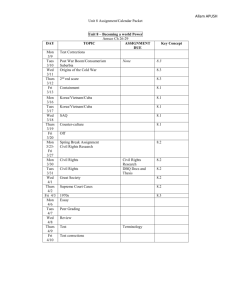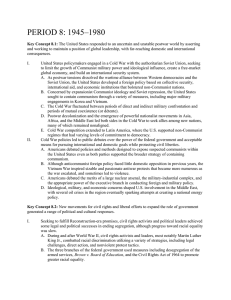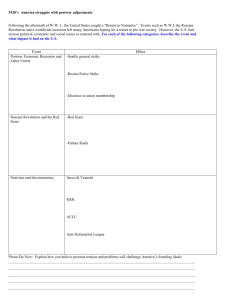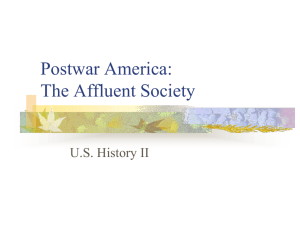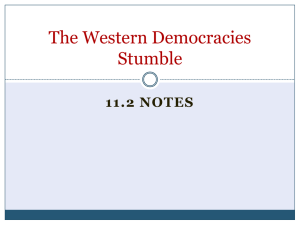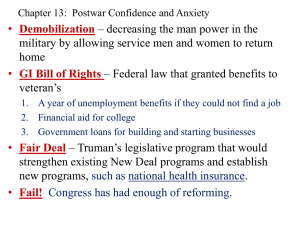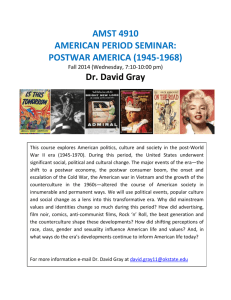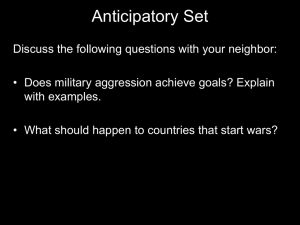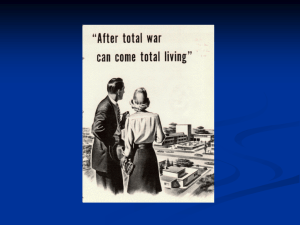Period 8 Key Concepts and Terms
advertisement
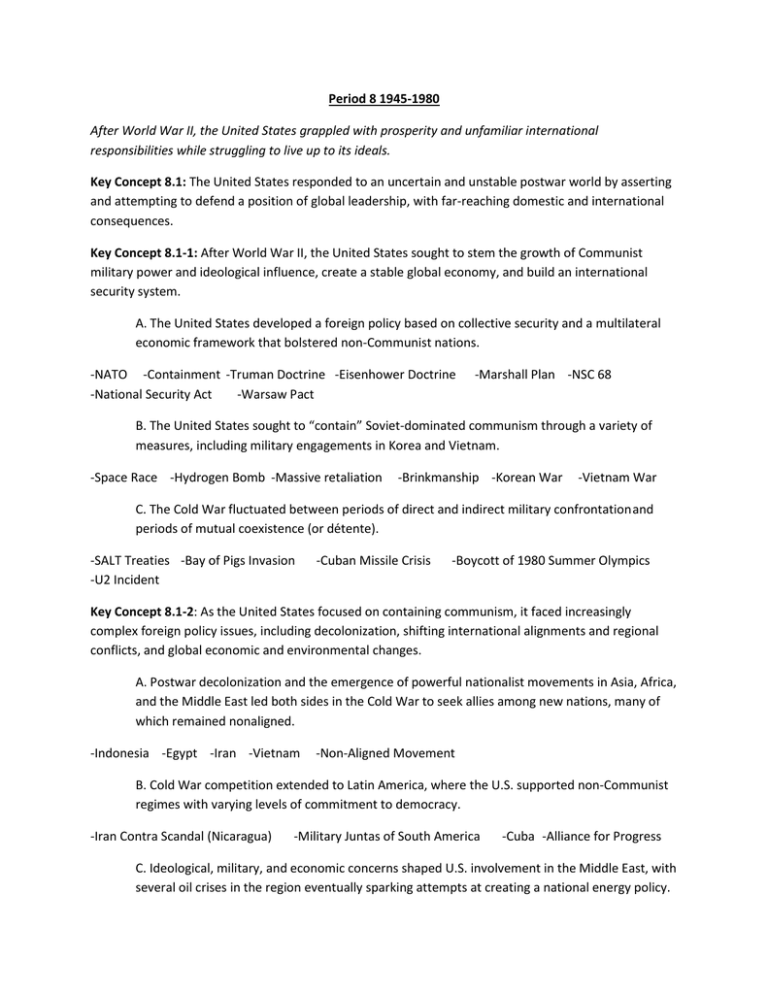
Period 8 1945-1980 After World War II, the United States grappled with prosperity and unfamiliar international responsibilities while struggling to live up to its ideals. Key Concept 8.1: The United States responded to an uncertain and unstable postwar world by asserting and attempting to defend a position of global leadership, with far-reaching domestic and international consequences. Key Concept 8.1-1: After World War II, the United States sought to stem the growth of Communist military power and ideological influence, create a stable global economy, and build an international security system. A. The United States developed a foreign policy based on collective security and a multilateral economic framework that bolstered non-Communist nations. -NATO -Containment -Truman Doctrine -Eisenhower Doctrine -National Security Act -Warsaw Pact -Marshall Plan -NSC 68 B. The United States sought to “contain” Soviet-dominated communism through a variety of measures, including military engagements in Korea and Vietnam. -Space Race -Hydrogen Bomb -Massive retaliation -Brinkmanship -Korean War -Vietnam War C. The Cold War fluctuated between periods of direct and indirect military confrontation and periods of mutual coexistence (or détente). -SALT Treaties -Bay of Pigs Invasion -U2 Incident -Cuban Missile Crisis -Boycott of 1980 Summer Olympics Key Concept 8.1-2: As the United States focused on containing communism, it faced increasingly complex foreign policy issues, including decolonization, shifting international alignments and regional conflicts, and global economic and environmental changes. A. Postwar decolonization and the emergence of powerful nationalist movements in Asia, Africa, and the Middle East led both sides in the Cold War to seek allies among new nations, many of which remained nonaligned. -Indonesia -Egypt -Iran -Vietnam -Non-Aligned Movement B. Cold War competition extended to Latin America, where the U.S. supported non-Communist regimes with varying levels of commitment to democracy. -Iran Contra Scandal (Nicaragua) -Military Juntas of South America -Cuba -Alliance for Progress C. Ideological, military, and economic concerns shaped U.S. involvement in the Middle East, with several oil crises in the region eventually sparking attempts at creating a national energy policy. -Suez Crisis -OPEC oil embargo -John Foster Dulles -Camp David Accords -Iranian Hostage Crisis -Yom Kippur War -Energy Crisis -Department of Energy -Environmental Protect Agency (EPA) -Weatherization Assistance Program Key Concept 8.1-3: Cold War policies led to continued public debates over the power of the federal government, acceptable means for pursuing international and domestic goals, and the proper balance between liberty and order. A. Americans debated policies and methods designed to root out Communists within the United States even as both parties tended to support the broader Cold War strategy of containing communism. -House of Un-American Activities Committee (HUAC) -Central Intelligence Agency (CIA) -"Hollywood 10" -Alger Hiss -Julius/Ethyl Rosenberg -The McCarran Internal Security Act -Joseph McCarty B. Although the Korean conflict produced some minor domestic opposition, the Vietnam War saw the rise of sizable, passionate, and sometimes violent antiwar protests that became more numerous as the war escalated. -Kent St. -1968 Democratic National Convention -Woodstock -Anti-Establishment -Counterculture -James Bevel -Student Non-violent Coordinating Committee (SNCC) -Tet Offensive -My Lai -Students for a Democratic Society (SDS) -Walter Cronkite -Military Draft C. Americans debated the merits of a large nuclear arsenal, the “military industrial complex,” and the appropriate power of the executive branch in conducting foreign and military policy. -Military Industrial Complex -George Keenan -Noam Chomsky -Interstate Highway Act Key Concept 8.2: Liberalism, based on anticommunism abroad and a firm belief in the efficacy of governmental and especially federal power to achieve social goals at home, reached its apex in the mid1960s and generated a variety of political and cultural responses. Key Concept 8.2-1: Seeking to fulfill Reconstruction-era promises, civil rights activists and political leaders achieved some legal and political successes in ending segregation, although progress toward equality was slow and halting. A. Following World War II, civil rights activists utilized a variety of strategies — legal challenges, direct action, and nonviolent protest tactics — to combat racial discrimination. -Fannie Lou Hamer -Thurgood Marshall -John Lewis -Malcolm X -Medgar Evers - Black Panthers - Martin Luther King Jr. -Stokely Carmichael -Rosa Parks -Selma March -Montgomery Bus Boycott B. Decision-makers in each of the three branches of the federal government used measures including desegregation of the armed services, Brown v. Board of Education, and the Civil Rights Act of 1964 to promote greater racial justice. -Civil Rights Act 1964 -Voting Rights Act 1968 -Affirmative Action -Fair Housing Act -Heart of Atlanta Motel Inc. v. USA 1964 -Swann v. Charlotte Mecklenburg Bd. of Edu. 1971 C. Continuing white resistance slowed efforts at desegregation, sparking a series of social and political crises across the nation, while tensions among civil rights activists over tactical and philosophical issues increased after 1965. -Little Rock Nine -George Wallace -Orville Faubus -Dixicrats -Strom Thurmond -Race Riots Key Concept 8.2-2: Stirred by a growing awareness of inequalities in American society and by the African American civil rights movement, activists also addressed issues of identity and social justice, such as gender/sexuality and ethnicity. A. Activists began to question society’s assumptions about gender and to call for social and economic equality for women and for gays and lesbians. -The Feminie Mystique -Gloria Steinem -Roe v. Wade -Equal Rights Amendment -Reed v. Reed 1971 B. Latinos, American Indians, and Asian Americans began to demand social and economic equality and a redress of past injustices. -Caesar Chavez -"Yellow power" -American Indian Movement (AIM) -Trail of Broken Treaties -Chicano Movement -United Farm Workers C. Despite the perception of overall affluence in postwar America, advocates raised awareness of the prevalence and persistence of poverty as a national problem, sparking efforts to address this issue. -Wage/Price Controls -Lyndon Johnson's "Great Society -JFK's New Frontier Key Concept 8.2-3: As many liberal principles came to dominate postwar politics and court decisions, liberalism came under attack from the left as well as from resurgent conservative movements. A. Liberalism reached its zenith with Lyndon Johnson’s Great Society efforts to use federal power to end racial discrimination, eliminate poverty, and address other social issues while attacking communism abroad. -Medicare/Medicaid -VISTA -Head Start -Job/Peace corps B. Liberal ideals were realized in Supreme Court decisions that expanded democracy and individual freedoms, Great Society social programs and policies, and the power of the federal government, yet these unintentionally helped energize a new conservative movement that mobilized to defend traditional visions of morality and the proper role of state authority. -Griswold v. Connecticut -Miranda v. Arizona -Brown v. Board of Education -Roe v. Wade C. Groups on the left also assailed liberals, claiming they did too little to transform the racial and economic status quo at home and pursued immoral policies abroad. -Students for a Democratic Society (SDS)/New Left -Black Panthers Key Concept 8.3: Postwar economic, demographic, and technological changes had a far-reaching impact on American society, politics, and the environment. Key Concept 8.3-1: Rapid economic and social changes in American society fostered a sense of optimism in the postwar years as well as underlying concerns about how these changes were affecting American values. A. A burgeoning private sector, continued federal spending, the baby boom, and technological developments helped spur economic growth, middle-class suburbanization, social mobility, a rapid expansion of higher education, and the rise of the “Sun Belt” as a political and economic force. -GI Bill of Rights -Truman's Fair Deal -Taft Hartley Act -Levittown -Baby Boom -White flight -Employment Act of 1946 -Sunbelt B. These economic and social changes, in addition to the anxiety engendered by the Cold War, led to an increasingly homogeneous mass culture as well as challenges to conformity by artists, intellectuals, and rebellious youth. -rock n roll music - Beat movement - The Affluent Society -Jack Kerouac -Allen Ginsberg -Ralph Ellison's Invisible Man -Greenwich Village -Edward Hopper -Death of a Salesman -James Dean -Marlon Brando -rock n roll C. Conservatives, fearing juvenile delinquency, urban unrest, and challenges to the traditional family, increasingly promoted their own values and ideology. -Phyllis Schalfly -Nixon's New Federalism -Dwight Eisenhower "dynamic conservatism" Key Concept 8.3-2: As federal programs expanded and economic growth reshaped American society, many sought greater access to prosperity even as critics began to question the burgeoning use of natural resources. A. Internal migrants as well as migrants from around the world sought access to the economic boom and other benefits of the United States, especially after the passage of new immigration laws in 1965. B. Responding to the abuse of natural resources and the alarming environmental problems, activists and legislators began to call for conservation measures and a fight against pollution. -Rachel Carson -Clean Air Act -Endangered Species Act -Environmental Protection Agency (EPA) Key Concept 8.3-3: New demographic and social issues led to significant political and moral debates that sharply divided the nation. A. Although the image of the traditional nuclear family dominated popular perceptions in the postwar era, the family structure of Americans was undergoing profound changes as the number of working women increased and many social attitudes changed. B. Young people who participated in the counterculture of the 1960s rejected many of the social, economic, and political values of their parents’ generation, initiated a sexual revolution, and introduced greater informality into U.S. culture. -Woodstock C. Conservatives and liberals clashed over many new social issues, the power of the presidency and the federal government, and movements for greater individual rights. -Watergate -Bakke v California -Phyllis Schlafly -Equal Rights Amendment (ERA)
